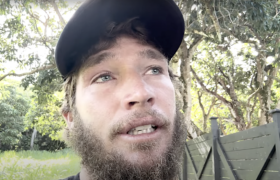Is dying in the mouth of a Great White worth the
kick of surfing?
As existential questions go, it’s a doozy. How
long after a fatal shark hit at your home beach would you get back
in the water?
For the surfers of Tuncurry, a precious stretch of east-facing
coastline a few hours north of Sydney and when y’combine its
neighbour Forster maybe the best waves on the north coast, it is,
literally, existential.
Every surfer in Tuncurry has gotta ask him, herself: Is dying in
the mouth of a Great White worth the kick of surfing?
Five days ago, a visiting surfer
from Newport in Sydney, fifty-nine-year-old Mark Sanguinetti, was
hit fifty yards off Nine-Mile beach by a fifteen-foot Great
White.
A witness on the beach said, “The shark came out of the water,
just smashed him, five seconds later he came round and hit him
again… Just the whole bone exposed, no meat on him at
all.”
A couple of days later, the joint was still crawling with ’em, a
Channel 7 drone filmed a White cruising the shoreline, fifty feet
from shore.
A little further out Whites were being caught, tagged and
released.
Now, think about it.
You live in Tuncurry.
You’ve surfed all your life.
You’ve felt an increasing Great White vibe there, hard not to
when a drone operator regularly releases footage of Whites swimming
among surfers and swimmers and the Department of Primary Industries
announces it has caught and released sixty-five Whites in a
six-month period, but not enough to keep you out of the drink.
No near misses, not in Tuncurry at least, although everyone
knows the story of Colin Rowland being dragged underwater by
a White at Bulls Paddock, twenty clicks away; not so many know the similar story
of Chris Little getting the same treatment a few years later at
nearby Boomerang Beach.
Still…
In May 2020, two Great Whites swam under three surfers at
Tuncurry, the drone footage evidence it seemed at the time that the
squad that patrols this stretch of beach found little of value in
the bones of human beings.
“We could hear a drone going and I’m like ‘where is that coming
from?’ And we turned around and there’s a dude running down the
beach to come wave us out of the water yelling ‘there’s two Whites
behind you!’” one of the surfers told Channel Nine’s The Today
Show.
“I actually found it quite reassuring that they’re not
interested in us, they were just swimming past and happened to run
into us,” said another.
“I reckon it happens on a near daily basis here,” said the
third.
Now?
The Whites are still there. No one’s coming to take ‘em away.
They’re protected so there’s gonna be more around every
year.
What do you do?
I grew up in the eighties, West Oz, and the spectre of a shark
attack was an abstract concept, to say the least.
Not one surfer had been killed by a shark, in Western Australia
history until 2004, long after I’d left, when Brad Smith was hit by
two Great Whites at Lefthanders.
(More fatal attacks on surfers would follow, 2005, 2010, 2o11,
12, 13, 16, 17, a couple in 2020 and a raft of non-deadly hits,
along with fatal attacks on swimmers and divers)
I’d moved to Queensland where the last hit was at Moreton Island
1992; down the coast in Byron, there hadn’t been a hit on a surfer
since Martin Ford at Tallows in 1982.
All pretty safe, and easy to avoid.
I kept an imaginary pencil in my head and would lick the nib and
draw a line through joints that hosted a fatal attack.
Until 2004, I only had to avoid Moreton Island, in Queensland,
Tallows in Byron and anywhere around Cactus.
In 2021, if you surf, and you live on Australia’s east coast, or
in Western Australia, Great Whites patrol the waters in greater
numbers, it is safe to presume, in living memory.
Healthy, abundant stocks.
What do you do?
When do you go back?
At Snapper, Occ was back the next day.
At J-Bay, after the non-fatal hit on Mick, Derek Hynd took an
hour or two before he dived in.
What about you?









